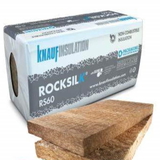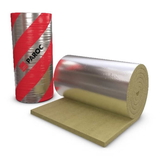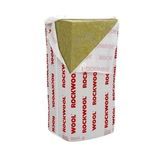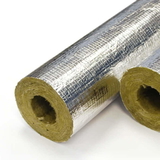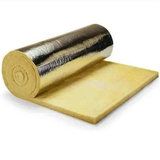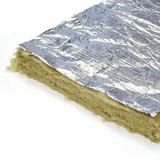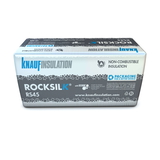- Blogs
- Glasswool Or Mineral Wool? A Guide to Choosing the Best Insulation for Your Project
Glasswool Or Mineral Wool? A Guide to Choosing the Best Insulation for Your Project

Insulation is a vital component of any building project, as it can improve the thermal performance, acoustic comfort, fire safety, and sustainability of your property. However, not all insulation materials are created equal, and choosing the right one can be a challenge.
In this article, we will compare two of the most popular types of insulation: glasswool and mineral wool. We will look at their properties, advantages, disadvantages, and applications, and help you decide which one is best for your needs.
What are Glasswool and Mineral Wool?
Glasswool and mineral wool are both made from mineral fibres that are spun into wool-like strands. They are also known as synthetic vitreous fibres (SVF) or man-made mineral fibres (MMMF). They are widely used as insulation materials because they have low thermal conductivity, high sound absorption, and excellent fire resistance.
- Glasswool is made from melted glass that is spun into fine fibres. It is also called fibreglass or glass fibre. It can be found in batts, rolls, loose-fill, or boards.
- Mineral wool is made from melted rock or slag that is spun into coarse fibres. It is also called rockwool or stone wool. It can be found in batts, rolls, or slabs.
How do Glasswool and Mineral Wool Compare?
Glasswool and mineral wool have many similarities, but also some differences that affect their performance and suitability for different applications. Here are some of the main factors to consider when comparing them:
- Thermal insulation: Both glass wool and mineral wool have similar R-values (a measure of thermal resistance) of around 0.57 per inch of thickness. This means they can effectively prevent heat loss or gain in your building.
- Acoustic insulation: Mineral wool has a higher density than glass wool, which makes it more effective at absorbing sound waves and reducing noise transmission. Mineral wool is therefore a better choice for soundproofing walls, ceilings, floors, or roofs.
- Fire resistance: Both glasswool and mineral wool are non-combustible and can withstand high temperatures without melting or burning. However, mineral wool has a higher melting point than glasswool (over 1000°C vs 700°C), which gives it an edge in fire protection.
- Moisture resistance: Mineral wool is more resistant to water than glasswool, as it does not absorb moisture or support fungal growth. Glasswool can get damp and lose its insulating properties if exposed to water or humidity. Mineral wool is therefore more suitable for wet or humid environments.
- Ease of installation: Mineral wool is easier to handle than glasswool, as it is stiffer and easier to cut and fit into place1. Glasswool is softer and more flexible, which makes it harder to install in tight spaces. However, glasswool is lighter than mineral wool, which makes it easier to transport and lift.
- Sustainability: Both glasswool and mineral wool are made from recycled materials, such as glass, sand, stone, or slag3. They are also energy-efficient, as they save more energy than they consume during their production and use. However, glasswool has a higher recycled content than mineral wool (up to 86% vs 70%), which makes it more environmentally friendly.
Tabular Comparison for Glasswool and Mineral Wool
|
Property |
||
|
Thermal Insulation |
Effective insulator |
Effective insulator |
|
Fire Resistance |
Non-combustible |
Non-combustible |
|
Sound Insulation |
Good sound absorption |
Good sound absorption |
|
Moisture Resistance |
Susceptible to moisture damage |
Resistant to moisture |
|
Environmental Impact |
Generally, not eco-friendly |
Generally eco-friendly |
|
Installation |
Easy to handle and install |
Maybe more rigid and harder to handle |
|
R-Value |
R-value varies based on density |
Typically has higher R-values |
|
Density |
Lower density |
Higher density |
|
Cost |
Often less expensive |
Can be more expensive |
This table provides a basic comparison of the properties of Glasswool and Mineral Wool. Glass wool is easier to handle and more affordable, while Mineral Wool generally offers better moisture resistance and higher R-values. The choice between them depends on specific project requirements and priorities.
Choosing the Right Insulation for Your Project
When it comes to insulating your building or space, two popular options to consider are glass wool and mineral wool insulation. Here, we address some frequently asked questions to help you make an informed decision:
Thermal Performance:
Both glass wool and mineral wool insulation offer excellent thermal performance, but mineral wool has higher thermal resistance (R-value), making it more effective at reducing heat transfer and maintaining comfortable indoor temperatures.
Soundproofing:
Both types are effective for soundproofing, with mineral wool having an advantage due to its density and superior sound insulation capabilities.
Combining Insulation:
You can use glass wool and mineral wool together to enhance thermal and acoustic performance, ensuring proper installation and adherence to building codes.
Key Differences:
Glass wool is made from glass fibres, while mineral wool comes from rock or stone fibres. The choice between them depends on your project's specific needs, with glass wool excelling in thermal performance and mineral wool in fire protection.
Glass Wool for Sound Insulation:
Glass wool is frequently used for sound insulation, thanks to its outstanding sound absorption properties.
R-Value:
The R-value of glass wool varies by product and thickness, but it typically offers superior thermal insulation.
Alternative Insulation Materials:
Other options include fibreglass insulation boards, cellulose insulation, spray foam, and polyurethane foam insulation, chosen based on your project's requirements and budget.
Weight and Roll Insulation:
Glass wool is lighter than mineral wool, making it easier to handle and install. It's available in roll form, providing a cost-effective and efficient insulation solution.
Fire Protection:
Mineral wool is the preferred choice for fire protection, as it is non-combustible and can withstand high temperatures without releasing toxic fumes.
Which One Should You Choose?
The choice between glasswool and mineral wool depends on your specific project requirements, budget, and preferences. Here are some general guidelines to help you decide:
- Choose glasswool if you want a lighter, cheaper, and more sustainable insulation material that can provide good thermal insulation for your building.
- Choose mineral wool if you want a denser, stronger, and more durable insulation material that can provide better acoustic insulation and fire protection for your building.
Difference Between Knauf Earthwool DriTherm Cavity Slab 37 and Rockwool RWA45 Slab
| Feature | Knauf Earthwool DriTherm Cavity Slab 37 | Rockwool RWA45 Slab |
| Material | Stone mineral wool | Stone mineral wool |
| Application | Cavity walls | Walls, floors and roofs |
| Thermal conductivity | 0.037 W/mK | 0.035 W/mK |
| Fire rating | Euroclass A1 | Euroclass A1 |
| Sound absorption | Good | Excellent |
| Water repellence | Yes | No |
| Price (per pack) | £19.20 | £19.20 |
| R-value (for 100 mm thickness) | 2.70 m2K/W | 2.86 m2K/W |
The main differences between the two products are:
- Knauf Earthwool DriTherm Cavity Slab 37 is designed specifically for cavity walls, while the Rockwool RWA45 Slab is more versatile and can be used for walls, floors and roofs.
- Rockwool RWA45 Slab has a lower thermal conductivity and a higher R-value than the Knauf Earthwool DriTherm Cavity Slab 37, which means it can provide more thermal insulation for the same thickness.
- Rockwool RWA45 Slab has a higher sound absorption coefficient than the Knauf Earthwool DriTherm Cavity Slab 37, which means it can reduce more noise and improve the acoustic comfort of the building.
- Knauf Earthwool DriTherm Cavity Slab 37 has a water repellent additive, while the Rockwool RWA45 Slab does not, which means it can resist moisture and prevent dampness and mould growth in the cavity.
These are some of the key differences between the two products that you should consider when choosing an insulation product.
Where Can You Buy Glasswool and Mineral Wool?
If you are looking for high-quality glass wool or mineral wool products for your insulation project, you can find them at Buy Insulation Online. We are a leading online supplier of insulation materials in the UK, offering a wide range of products at competitive prices.
Whether you need batts, rolls, slabs, boards, or loose-fill insulation, we have it all in stock and ready to deliver to your doorstep. You can browse our website Buy Insulation Online to find the best insulation products for your needs.
Frequently Asked Questions
Q: What is the difference between glass wool and mineral wool insulation?
A: Glass wool and mineral wool insulation are two types of thermal insulation materials. The main difference lies in the composition of the fibers used. Glass wool insulation is made from glass while mineral wool insulation is made from rock minerals or slag.
Q: Which is better for insulation, glass wool or mineral wool?
A: The choice between glass wool and mineral wool insulation depends on the specific requirements of your project. Glass wool insulation has better sound insulation properties and is lighter than mineral wool. On the other hand, mineral wool insulation has higher thermal resistance and is denser than glass wool.
Q: What are the advantages of glass wool insulation?
A: Glass wool insulation is known for its excellent sound insulation properties. It is also lightweight and easy to install. Glass wool insulation is made from recycled glass, making it an environmentally friendly choice. Additionally, it has good fire resistance and does not promote the growth of mold or mildew.
Q: What are the advantages of mineral wool insulation?
A: Mineral wool insulation has excellent thermal resistance properties, making it highly effective in reducing heat transfer. It is also denser than glass wool, providing better sound insulation. Mineral wool insulation is made from rock minerals or slag, which makes it naturally fire-resistant. It is also resistant to moisture, mold, and pests.
Q: Is fiberglass insulation the same as glass wool insulation?
A: Yes, fiberglass insulation is another term for glass wool insulation. It is made from fine fibers of glass and is commonly used for thermal and acoustic insulation purposes.
Q: How is glass wool insulation made?
A: Glass wool insulation is made by melting glass and spinning it into fibres. The fibres are then processed and bonded together to form the insulation material. The manufacturing process involves the use of high temperatures and binders to ensure the fibres are properly bonded.
Q: How is mineral wool insulation made?
A: Mineral wool insulation is made by melting rock minerals or slag and spinning them into fibres. The fibres are then processed and formed into insulation products, such as boards or rolls. The manufacturing process may also involve the addition of binders or coatings for improved performance.
Conclusion
Glasswool and mineral wool are both excellent insulation materials that can improve the comfort and efficiency of your building. However, they have different properties and advantages that make them more suitable for different applications.
By comparing their thermal insulation, acoustic insulation, fire resistance, moisture resistance, ease of installation, and sustainability, you can choose the best insulation material for your project. If you need any help or advice, feel free to contact us at Buy Insulation Online. We are happy to assist you with your insulation needs.

Samuel Hitch
Managing Director
Buy Insulation Online.
Leave A Reply
Your feedback is greatly appreciated, please comment on our content below. Your email address will not be published. Required fields are marked *
